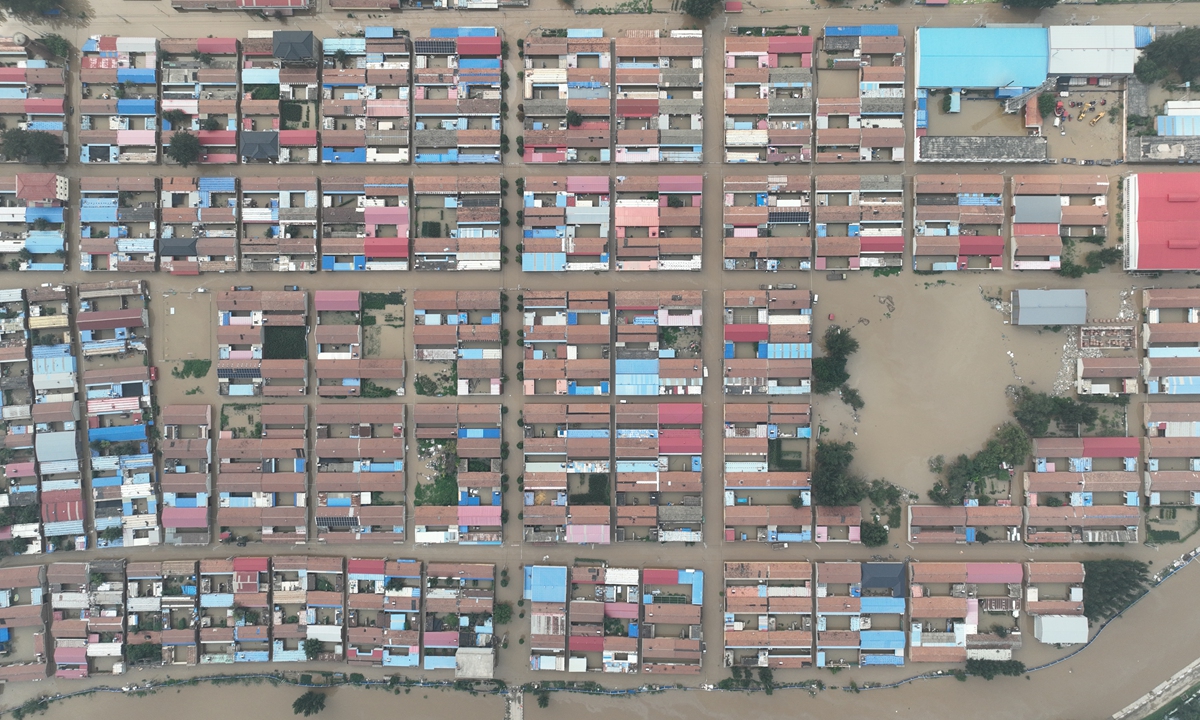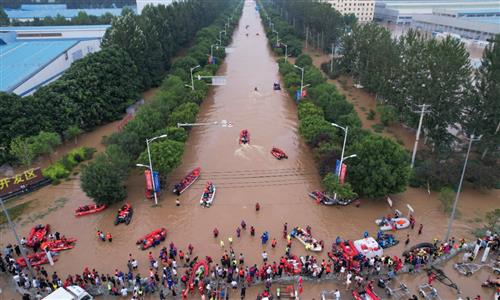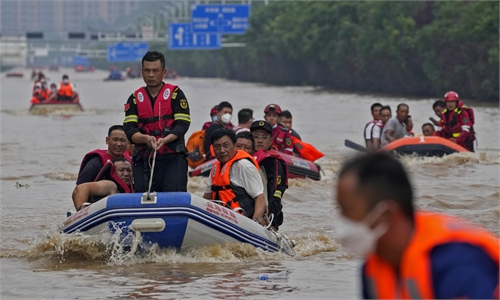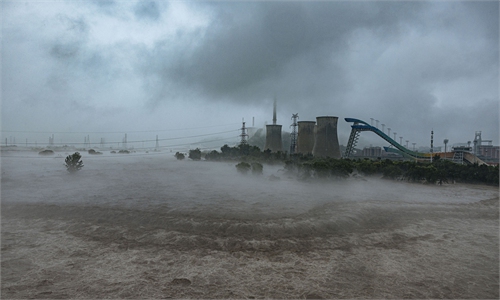Hebei Province relocates over 1.2 mln people; floodwater in storage basins expected to recede within one month

Pcitured is Zhanggezhuang Village, a village in a floodwater detention area within Langfang, North China's Hebei Province. Photo: IC
North China's Hebei Province has relocated over 1.2 million people from flooded areas, where floodwaters have started to recede since torrential rains have ceased. Additionally, floodwater in storage and detention basins is expected to recede within one month.
China's State Flood Control and Drought Relief Headquarters continued to remain at a Level-II emergency response for flooding in North China's Beijing and Tianjin municipalities, provinces of Hebei and Shanxi, and Central China's Henan Province, as flood waters in the middle reaches of the Haihe River Basin progressed downstream. Various flood control measures, including eight flood storage and detention basins, diversion channels, and 155 large- and middle-scale floodwater detention reservoirs have been successively put into use.
Due to the joint impact of Typhoon Doksuri and cold and warm air currents, torrential rains continued for nearly 144 hours in Hebei between 8 am on July 27 and 8 am on August 2, with an average rainfall of 146.2 millimeters across the province. The total precipitation of 27.5 billion cubic meters amounted to twice the total reservoir capacity of all the large- and middle-scale reservoirs across the province.
Across Hebei Province, seven flood storage areas were put into use to divert and reduce 1.8 billion cubic meters of floodwater, playing a significant role in flood diversion and preventing the reservoirs and dikes from collapse and protecting major infrastructure from damage.
As of Thursday morning, about 1.23 million residents have been relocated in Hebei to safe places, including 857,200 residents from the flood storage areas. Hebei has dispatched more than 4,700 rescue teams with more than 100,000 personnel, and sent more than 2,200 working groups to affected areas
In Zhuozhou, a city neighboring Beijing, with a permanent population of 600,000 people, two flood storage areas, Xiaoqinghe with 67 villages across seven townships and Langouwa with 57 villages across three townships, were put into use for the first time.
The city has become the worst-hit flood region after days of heavy rain. Some speculation circulating online attributed the waterlogging in Zhuozhou to the flood discharges carried out as part of efforts to protect Beijing. According to Cheng Xiaotao, deputy chief engineer of the China Institute of Water Resources and Hydropower Research, such speculation is not accurate, since the adoption of flood storage areas is an overall consideration.
Generally speaking, the effectiveness of a flood detention area is more relevant to downstream areas rather than upstream areas. Since Beijing is located in the upstream area, the use of the flood detention areas benefits Tianjin more.
However, for some places which have never been used as or planned to be used as flood detention areas, such as Zhuozhou, they can suffer from severe waterlogging due to a lack of experience in coping with emergencies, Ma Jun, director of the Beijing-based Institute of Public and Environmental Affairs, told the Global Times on Thursday.
Ma noted that lessons have to be learned from this experience, including timely notifying residents and timely transferring personnel and their belongings.
According to Li Na, deputy director of the Department of Water Resources of Hebei Province, the average rainfall in Zhuozhou amounted to 398 millimeters as of Wednesday evening during this rainstorm. Despite easing rainfall, it will take some time for water levels to recede and 300 million to 400 million cubic meters of water is expected to pass through Zhuozhou, China Central Television (CCTV) reported.
According Li, the flood storage and detention basins in Zhuozhou have proven to be very effective in reducing the impact of flooding and mitigating potential damage to the downstream Xiong'an New Area and Tianjin Municipality.
For some villages used as flood storage and detention basins, it will take as little as one week for water levels to recede, whereas it will take longer, even up to one month, for the water to recede in low-lying areas, Li noted.
Ma noted that special attention has to be paid to the ecological environment and purification and disinfection has to be carried out to avoid disease after a major disaster.
China's Flood Control Law enacted in 1997 explicitly stipulates that compensation must be provided to areas which are used by the country as flood detention areas, and the interim measures for compensation for the use of flood detention areas issued in 2000 also detail compensation standards.
According to laws and regulations, up to 70 percent of losses can be compensated for houses damaged by flooding, while owners of destroyed crops and lost livestock can be compensated at 40 percent to 70 percent of the average annual output value of the previous three years.
In Tianjin, the Jinghai district has been used as a flood storage area since Thursday and over 30,000 residents from 23 villages in the district were relocated. The district flood control and drought relief headquarters addressed the residents in a letter on Wednesday that the country and the people in the Beijing-Tianjin-Hebei region appreciate their contributions and their devotion will be recorded in history.
The National Meteorological Center announced that the rainfall has moved into Northeast China since Wednesday with the possibility of extreme heavy rains. The approaching remnants of Typhoon Doksuri is expected to bring storms to the middle and eastern parts of Jilin Province and the southeastern part of Heilongjiang Province between Wednesday and Friday.
The flood control authorities in the cities of Harbin and Mudanjiang in Heilongjiang began implementing flood control emergency measures on Wednesday and Thursday, including suspending classes at schools and training institutions and halting construction activities and outdoor activities.
According to Ma, heavy rains are forecast to mainly hit the Songhua River basin, which contains a vast water system, on Friday. The mountains upstream will intensify the speed of flooding, which will pose big challenges for some major cities along the river.



